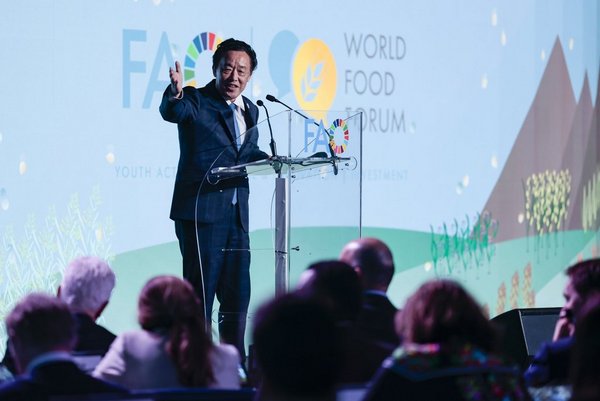 Read this article in French
Read this article in French- Share this article
- Subscribe to our newsletter
Agrifood systems transformation accelerates climate action
The 2023 flagship event of the World Food Forum (WFF) took place from 16 to 20 October at the Headquarters of the Food and Agriculture Organization of the UN (FAO) in Rome, Italy – as well as online. The theme of this year’s event was “Agrifood systems transformation accelerates climate action”.
Aiming to address the pressing issues in agrifood systems and forge new paths towards a more sustainable, resilient, inclusive and hunger-free future, the event brought together over 5,000 in-person participants, with more than 20,000 joining online.
The WFF’s flagship event comprises the WFF Global Youth Forum, the FAO Science and Innovation Forum and the FAO Hand-in-Hand Investment Forum. It supports the need for an intergenerational dialogue among leaders and partners in agrifood systems.
Bioeconomy as a catalyst for agrifood systems transformation
In his opening remarks at the event Bioeconomy: the catalyst for agrifood systems transformation the Director-General of FAO, QU Dongyu, stressed the importance of promoting a bioeconomy that is inclusive and adapted to local contexts. The event was one of eight meetings focussing on bioeconomy at this year’s edition of the Science and Innovation Forum.
According to the FAO, the bioeconomy can be a catalyst for addressing the current climate crisis and achieving global agrifood sustainability through a more efficient and responsible management of our natural resources.
Its potential goes far beyond cutting greenhouse gas emissions and restoring biodiversity. It opens up new opportunities for green development and jobs in agriculture and other sectors, bolstering food security and nutrition, rural livelihoods, the lives of Indigenous Peoples and local communities, and innovation at all levels of society.
According to one projection, a resource-efficient, circular bioeconomy could be worth as much as USD 7.7 trillion by 2030. Around 60 countries and regions already have bioeconomy-related strategies and another 10 are currently developing them.
However, there can be trade-offs. Planting a crop for bioenergy instead of human or animal consumption, for example, could negatively impact local livelihoods, human food security or livestock feed security. Equally, not everything that’s billed as bioeconomy is sustainable.
Artificial intelligence and digital tools for farmers
The event AI and Digital Tools for Climate Resilient Agrifood Systems also featured in the Science and Innovation stream of the World Food Forum and focused on the technological innovations that are already revolutionising agriculture.
In his keynote speech, FAO Chief Economist Máximo Torrero presented some exciting examples of digital tools already developed by FAO. One of the most recent is a digital application called FLAPP (the FAO Food Loss App), which helps analyse where and why food losses happen, allowing for more targeted interventions in reducing waste.
He also pointed to the on-the-ground impact of the digital tool “Ugani Kiganjani” for farmers in Tanzania. This mobile app provides farmers with weather forecasts and advisory services so that they can prepare the land or harvest accordingly.
Najat Mokhtar, Deputy Director-General and Head of the Department of Nuclear Sciences and Applications at the International Agency for Atomic Energy (IAEA), highlighted the innovative use of cosmic ray neutron sensors as an agricultural solution. An area of work within the Joint FAO/IAEA Centre of Nuclear Techniques in Food and Agriculture, these sensors allow scientists to track neutrons in the atmosphere and determine how much water is already in the soil. This information offered to farmers can then guide them on when or when not to irrigate.
Hand-in-Hand Investment Forum
At the 2023 Hand-in-Hand Investment Forum, governments from two critical regions, Central America’s Dry Corridor and Africa’s Sahel, presented dozens of projects aimed at boosting agricultural production and food security in a sustainable and profitable way.
The event also saw participating governments meet with traditional donors, multilateral development banks and representatives of the private sector and foundations.
While 31 countries pitched national-level investable projects in agrifood systems, considerable attention was given to two regional initiatives involving multiple countries facing similar challenges. The two initiatives generated more than USD 6 billion in pitches for around 110 investments affecting 149 million beneficiaries. The investments ranged from small-scale irrigation networks and water storage facilities to digital soil mapping and measures to boost regional trade.
The Dry Corridor and Sahel both face shared issues, in particular drought and the inadequate management of water resources. These problems can trigger conflict and forced migration. Crafting joint solutions can therefore make it easier to help countries attract partners and investors.
(FAO/ile)
More information:





Add a comment
Be the First to Comment